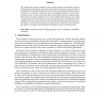Free Online Productivity Tools
i2Speak
i2Symbol
i2OCR
iTex2Img
iWeb2Print
iWeb2Shot
i2Type
iPdf2Split
iPdf2Merge
i2Bopomofo
i2Arabic
i2Style
i2Image
i2PDF
iLatex2Rtf
Sci2ools
100
click to vote
JSA
1998
1998
Windowed active sampling for reliable neural learning
The composition of the example set has a major impact on the quality of neural learning. The popular approach is focused on extensive preprocessing to bridge the representation gap between process measurement and neural presentation. In contrast, windowed active sampling attempts to solve these problems in an on–line interaction between problem selection and learning. This paper provides an unified view on the conflicts that may pop–up within a neural network in the presence of ill–ordered data. It is marked that such conflicts become noticeable from the operational learning characteristics. An adaptive operational strategy is proposed that closes the representation gap and its working is illustrated in the diagnosis of power generators.
Related Content
| Added | 22 Dec 2010 |
| Updated | 22 Dec 2010 |
| Type | Journal |
| Year | 1998 |
| Where | JSA |
| Authors | Emilia I. Barakova, Lambert Spaanenburg |
Comments (0)

